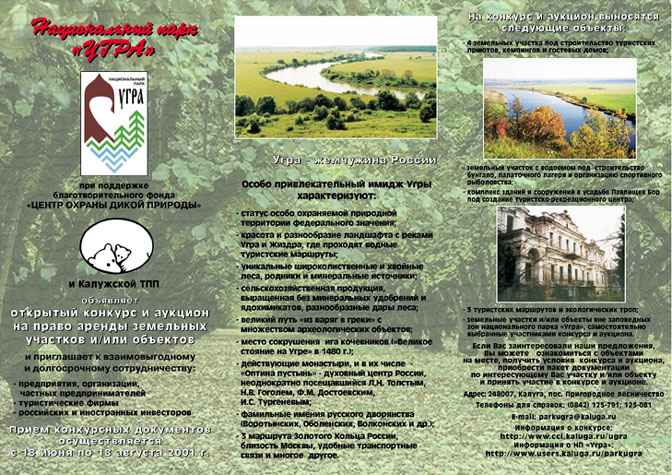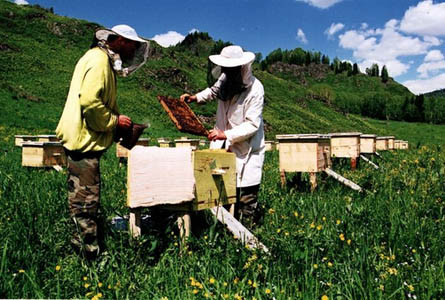|
National Parks - Benefits for Local Communities
Armen Grigoryan,
Biodiversity Conservation Center
Russian natural parks became more or less not involved in local community
life although other land users and owners are doing their business now within
park boundaries.
It should be especially noted that current federal funding is absolutely
not enough for natural parks and without close participation of local and
regional authorities, private business, and local population holistic and
aiming to the future development of national parks, as well as fulfilling
the tasks which promoted appearance of the national parks, often become
practically impossible.
Do national parks have alternative possibilities to get deserving funding
and keep their integrity as a managed object? Do they have opportunities
to develop without opposition with the local population and local and regional
authorities? Are national parks for local and regional authorities only
federal units that just make impossible using reach natural resources and,
therefore, do not allow solving hot local social and economic problems?
Could and should national parks become initiative centers of sustainable
development in their regions?
To get answers to these hot questions and to outline main directions for
national parks activity was the task of the big BCC projects 'Strategy of
Russian national parks management' which was developed in collaboration
with the British conservation association RHS and with financial support
from the Great Britain Department for International Development (DFID).
With a low employment level and poverty of the local population, nature
management restrictions on the territory of national parks and reserves
without providing alternative livelihood sources provoke environmentally
unfriendly using of natural resources and do not promote natural heritage
conservation and social conditions improvement.
According to the federal legislation, tasks of protected area administrations
do not include solving socio-economic problems on their territories. The
major task of protected areas was and still is nature protection with special
services, as well as scientific researches.
The main idea of the BCC project is that administrations of national
parks and biosphere reserves are driving forces for solving socio-economic
problems in ecologically friendly manner and, therefore, they become growth
and formation centers for the model of sustainable socio-economic development
and also centers of new approaches to nature conservation.
For doing that, BCC tested mechanisms of local population sustainable
livelihood (PSL program) and, using them, formed partnership models
for protected areas, on one hand, and local people and other stakeholders,
on the other.
The following protected areas were selected as model territories for PSL
program testing: national parks'Ugra' (Kaluga region) and 'Smolyenskoye
Poosyerye' (Smolyensk region) and biosphere reserves 'Katunsky' (Republic
of Altai) and Tsentralno-Lesnoy (Tvyer region). The national parks obtained
the biosphere reserve status as a result of the project. The main organizational
phase of the program took place in 2000-2002 but the developed sustainable
livelihood mechanisms still work successfully.
The number and content of sustainable livelihood projects depended on local
conditions. The following projects were implemented on the model territories:
- Organizing institutional mechanisms of local population micro-crediting
on all model territories (the basic livelihood project). BCC provided the
sum equal five thousand US dollars (in rubles) to each of model territories;
- Tender for the right to lease sites, objects, and tourist routes on the
protected area territory;
- Development of rural 'green' tourism in protected areas (guest service);
- Revival of local crafts;
- Using a protected area logo for marketing local products;
- Development of fishing tourism in protected areas;
- Projects of special trainings for local coordinators.
The PSL program was implemented step by step. Its core part on the model
territories was the development of the micro-crediting mechanism.
In the national park 'Ugra', the micro-crediting institutional mechanism
was developed on the basis of the State fund for small business support
of Kaluga region (SFSBS). An open competition was announced in mass-media
calling for business-projects from people living in the park and its buffer
zone. Rural meetings were conducted with training programs for potential
borrowers. The main using of credits was development of ecologically friendly
agriculture and guest service in private homes. The credits are returned
on schedule, no funds were lost. The income of the PSL program participants
in the national park 'Ugra' has increased by about 30%.

In the national park 'Smolyenskoye Poosyerye', the micro-crediting program
was developed on the basis of Demidovsky district administration. Consultations
for local population were conducted, the learning program of basic business
planning was implemented. Over the four years, fund resources were completely
used (turned around) more than four times, credits were fully returned,
and the return schedule was broken only in two cases but it was compensated
later. Financed 30 proposals to the amount of 573 000 Rubles (equal twenty
thousand US dollars). The main using of credits was visitors service, ecologically
friendly agriculture, and crafts.
In the 'Tsentralno-Lesnoy' biosphere reserve, the micro-crediting mechanism
was developed on the basis of Nelidovsky district administration. Five credits
were issued (agriculture, poultry, guest house organizing). This model area
was used to work out the insurance mechanism for agricultural risks. Although
the micro-crediting program in the reserve does not develop fast enough (for
a number of reasons), it should be noted that it has a potential of self-developing
on the basis of examples of the first borrowers.
In the 'Katunsky' biosphere reserve, the institutional micro-crediting mechanism
was developed on the basis of the reserve. A training program was implemented.
Five micro-loans were issued, all of them were used for producing and packing
of organic local products, first of all mountain honey. Borrowers established
a non-governmental association of honey producers, other local apiarists participating
in its activity. The credits were completely returned. An average income increase
of micro-crediting project participants was about 30%. The number of people
whose income increased as a result of their projects implementation totals 16
persons (including borrowers family members and their employees).

|
A tender for the right to lease sites, objects, and tourist routes was
tested in the national park 'Ugra'. It was the first case in Russia when
an open competition was announced in a protected area for a long-term lease
of objects and sites within park and buffer zone boundaries. BCC developed
all documents necessary for the tender and made agreements with land owners
and users. The tender was approved by the Russian Ministry of Natural Resources.
Tender informational support was provided by the Kaluga region chamber of
commerce and BCC.
In national parks 'Ugra' and 'Smolyenskoye Poosyerye', projects on fishing
tourism development were implemented. Involving local people in tourist
service became an important activity. Fishing tours were developed and presented
at a fishing exhibition in Moscow.
Practical testing of 'green' tourism projects (guest service) was conducted
in national parks 'Ugra' and 'Smolyenskoye Poosyerye'. Tourist companies,
public organizations, various authorities, and district administrations
were involved in the projects. The information about private home staying
was put together in special booklets.
In the national park 'Smolyenskoye Poosyerye', a non-governmental association
of home owners was established, their service is well marketed. The number
of available and involved in the guest service homes of local people totals
26. In 'Ugra' national park, 38 guest homes were found in two districts,
they were described and classified. Some home owners were contracted by
the national park for short-term visitor staying. The national park along
with BCC has analyzed the project experience and issued a manual for potential
guest home owners on tax, legal, and insurance problems of tourist hosting
in private guest homes.
Increase of visitor numbers in protected areas gives rise to souvenir consumption.
It is meaningful to satisfy this demand by local crafts revival. In the
biosphere reserve 'Katunsky' and national park 'Smolyenskoye Poosyerye',
appropriate non-commercial partnerships were established which became the
centers uniting local craftsmen, helping them in training, instrument and
equipment supply, and in marketing their products.
To increase local people income taking into consideration the potential
of the biosphere reserve 'Katunsky' as an ecologically clean territory,
a project on marketing local agriculture products (first of all mountain
honey) using the reserve logo was implemented. The reserve 'Katunsky' trade
mark was officially registered and the product (mountain honey) comes to
the markets of Moscow, St.-Petersburg, and Novosibirsk marked with the reserve
logo. In 2002, honey with the reserve logo was awarded a medal for the best
Russian good at the exhibition 'Regions of Russia' (Exhibition of National
Economy Achievements).

All PSL program participants specially outline its great importance for
creating a positive image of model national parks and biosphere reserves
in local communities.
The developed institutional mechanisms of micro-loans continue their successful
functioning and have all possibilities for sustainable development in the
future especially given that local resources are becoming involved in the
support of local micro-loans funds. This work is the most active in national
parks 'Ugra' and 'Smolyenskoye Poosyerye'.
The commissions (councils) established for direct management of micro-loan
projects include not only protected areas administrations but also local
authorities, public organizations, and local communities representatives.
These commissions already discuss broader problems related with the perspectives
of protected areas development within the framework of regional socio-economic
development.
One of indirect evidences of the fact that integrated approaches of the
PSL program are correct is establishing a public organization "Club
of friends of the national park 'Smolyenskoye Poosyerye'" initiated
by the Demidovsky district administration (Smolyensk region). A similar
friends club was established in the 'Katunsky' biosphere reserve (Republic
of Altai). PSL program participants, therefore, express their willingness
to extend their participation in the protected area life and not to lose
productive mutual contacts.
The questioning of the PSL program participants conducted by the Biodiversity
Conservation Center and analysis of opinions of protected areas heads and
local authorities have shown that the BCC PSL programs are very effective
for establishing productive relationships between protected areas and local
communities. As estimated, their effect was often bigger than the effect
of traditional ecological education programs.
Now the Biodiversity Conservation Center receives requests from national
parks and biosphere reserves for practical assistance in implementation
of PSL programs on their territories.
Sours: Prirodno-resursnye vedomosti newspaper, # 15-16, April
2004, p.16.
The paper in Russian
| top |
| 
